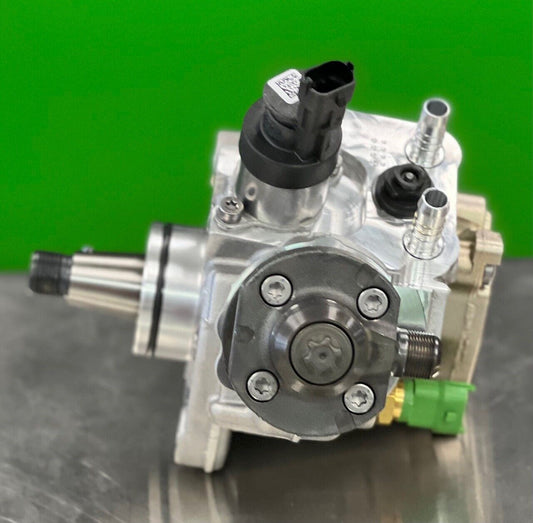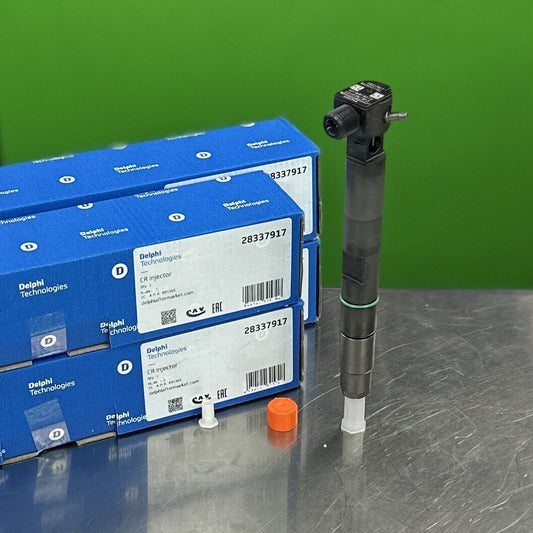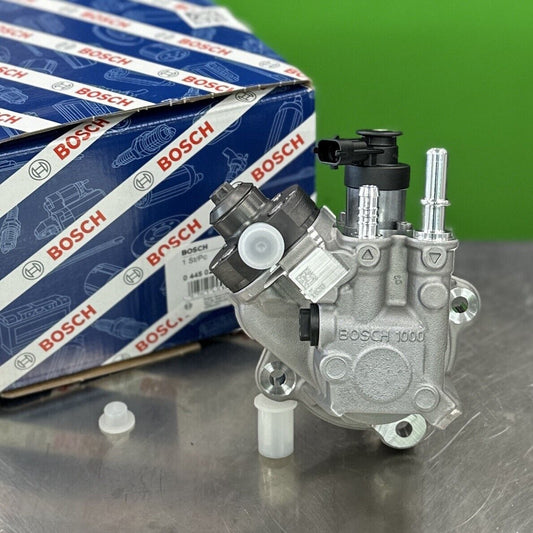High-Pressure Fuel Pumps and Injectors for Diesel Engines
Diesel engines are known for their fuel efficiency and power, but they rely on a complex system of components to operate properly. One of the most important components is the high-pressure fuel pump (HPFP). The HPFP is responsible for delivering fuel to the injectors at a high enough pressure to atomize the fuel and create a fine mist that can be burned efficiently.
There are two main types of HPFPs: mechanical and electronic. Mechanical HPFPs use a camshaft or other mechanical linkage to operate the pump. Electronic HPFPs, on the other hand, use an electric motor to control the pump's operation.
Mechanical HPFPs
Mechanical HPFPs are the simpler and more affordable type of HPFP. They are typically used in older diesel engines. Mechanical HPFPs can be either inline or rotary.
Inline HPFPs are the most common type of mechanical HPFP. They are located in the engine block and have a single piston that pumps fuel.
Rotary HPFPs have a rotating camshaft that drives the pump's plungers. Rotary HPFPs are typically more efficient than inline HPFPs, but they are also more complex and expensive.
Electronic HPFPs
Electronic HPFPs are more advanced than mechanical HPFPs and offer a number of advantages, including:
- Improved fuel efficiency
- More precise fuel delivery
- Reduced emissions
Electronic HPFPs are typically used in newer diesel engines. They can be either inline or rotary.
Inline Electronic HPFPs are similar to mechanical inline HPFPs, but they use an electric motor to control the pump's operation.
Rotary Electronic HPFPs are similar to mechanical rotary HPFPs, but they use an electric motor to control the pump's camshaft.
Injectors
The injectors are responsible for delivering the fuel from the HPFP to the combustion chamber. Injectors are typically made of high-quality materials, such as stainless steel or tungsten carbide, to withstand the high pressures and temperatures of the combustion chamber.
There are two main types of injectors: pintle and solenoid.
Pintle injectors are the most common type of injector. They use a pintle, or needle, to control the flow of fuel.
Solenoid injectors use a solenoid to control the flow of fuel. Solenoid injectors are more efficient than pintle injectors and can be used to deliver more precise fuel amounts.
High-Pressure Fuel Pumps and Injectors for Specific Diesel Engines
LB7 Injectors
The LB7 injector is a solenoid injector that is used in the 6.6L Duramax engine. The LB7 injector is a high-pressure injector that can deliver up to 25,000 psi of fuel pressure.
6.7 Cummins Injectors
The 6.7 Cummins injector is a solenoid injector that is used in the 6.7L Cummins engine. The 6.7 Cummins injector is a high-pressure injector that can deliver up to 30,000 psi of fuel pressure.
5.9 Cummins Injectors
The 5.9 Cummins injector is a pintle injector that is used in the 5.9L Cummins engine. The 5.9 Cummins injector is a high-pressure injector that can deliver up to 30,000 psi of fuel pressure.
7.3 idi Injector Pump
The 7.3 idi injector pump is a mechanical injector pump that is used in the 7.3L Power Stroke engine. The 7.3 idi injector pump is a high-pressure pump that can deliver up to 25,000 psi of fuel pressure.
Choosing the Right High-Pressure Fuel Pump or Injector
The right high-pressure fuel pump or injector for your diesel engine depends on a number of factors, including:
- The type of engine you have
- The year and model of your engine
- The horsepower and torque ratings of your engine
- Your budget
If you are unsure of which high-pressure fuel pump or injector is right for your diesel engine, you should consult with a qualified mechanic.
High-Pressure Fuel Pumps and Injectors for Diesel Engines: A Deep Dive
Diesel engines are the workhorses of the automotive world, renowned for their durability, fuel efficiency, and raw power. But their strength lies not just in their robust construction, but also in the intricate interplay of precision-engineered components. Among these, the high-pressure fuel pump (HPFP) and injectors reign supreme, orchestrating the delicate dance of fuel delivery and combustion.
HPFPs: The Heart of the Fuel System
Imagine a tiny, tireless maestro, relentlessly pushing fuel against immense pressure. That's the HPFP in action. Its role is simple yet crucial: to take diesel from the tank and compress it into a fine mist, ready for injection into the combustion chamber. This pressurized mist ensures thorough atomization, leading to cleaner, more efficient burning.
There are two main maestros in the HPFP world:
- Mechanical HPFPs: These veterans rely on the tried-and-true camshaft or other mechanical linkages to drive the pump. They're often found in older engines, known for their simplicity and affordability.
- Electronic HPFPs: These are the new-age maestros, employing electric motors to control the pump's operation. They offer greater precision, improved fuel efficiency, and reduced emissions, making them the go-to choice for modern engines.
Both mechanical and electronic HPFPs come in two styles:
- Inline HPFPs: These workhorses sit snugly within the engine block, featuring a single piston that pumps the fuel with relentless rhythm.
- Rotary HPFPs: These rely on a rotating camshaft to drive multiple plungers, offering superior efficiency but at the cost of increased complexity and expense.
Injectors: The Final Frontier
Once the HPFP has done its job, the fuel's journey continues to the injectors. These precision nozzles, often crafted from high-grade materials like stainless steel or tungsten carbide, are the gatekeepers of the combustion chamber. They receive the pressurized fuel and, with meticulous timing, inject it into the chamber like a microscopic ballet of droplets.
Injectors come in two main flavors:
- Pintle injectors: These classic designs utilize a needle-like pintle to control the fuel flow. They're reliable and widespread, making them a popular choice for many engines.
- Solenoid injectors: These modern marvels leverage electromagnets (solenoids) to manage the fuel flow with unmatched precision. They enable more efficient combustion and precise fuel metering, making them the preferred choice for high-performance engines.
Matching the Maestro to the Engine: Choosing the Right HPFP and Injector
Selecting the perfect HPFP and injector combination for your diesel engine is akin to finding the ideal musical pairing for a specific symphony. Several factors play a crucial role in this harmonious union:
- Engine type: Different engines have specific fuel delivery requirements, dictating the type and capacity of the HPFP and injectors needed.
- Year and model: Technological advancements mean newer engines often demand more sophisticated HPFP and injector setups.
- Horsepower and torque: Engines with higher output ratings require HPFPs and injectors capable of delivering the necessary fuel volume and pressure.
- Budget: Costs vary depending on the complexity and performance of the chosen HPFP and injector combination.
Remember, consulting a qualified mechanic is always wise when navigating the intricate world of diesel fuel systems. They can assess your specific engine's needs and recommend the ideal HPFP and injector setup for optimal performance and longevity.
Maintaining the Harmony: Tips for HPFP and Injector Care
Just like any finely tuned instrument, HPFPs and injectors require regular care to keep the fuel symphony flowing smoothly. Here are some key maintenance tips:
- Regular inspections: Schedule annual checkups with a qualified mechanic to ensure your HPFP and injectors are in top shape.
- Fuel filter changes: Don't underestimate the power of a clean fuel filter! Replace it regularly to prevent contaminants from harming your HPFP and injectors.
- Fuel quality matters: Using high-quality diesel fuel helps prevent premature wear and tear on your fuel system components.
- Listen to your engine: Unusual noises, decreased performance, or smoke can indicate HPFP or injector issues. Don't hesitate to seek professional help if you notice any warning signs.
By understanding the intricate dance of HPFPs and injectors, appreciating their critical role in diesel engine performance, and implementing proper maintenance practices, you can ensure your diesel engine continues to deliver the power and efficiency it's renowned for, mile after mile.
So, the next time you hear the rhythmic rumble of a diesel engine, remember the silent symphony taking place within – a testament to the masterful engineering of HPFPs and injectors, the unsung heroes of diesel power.



